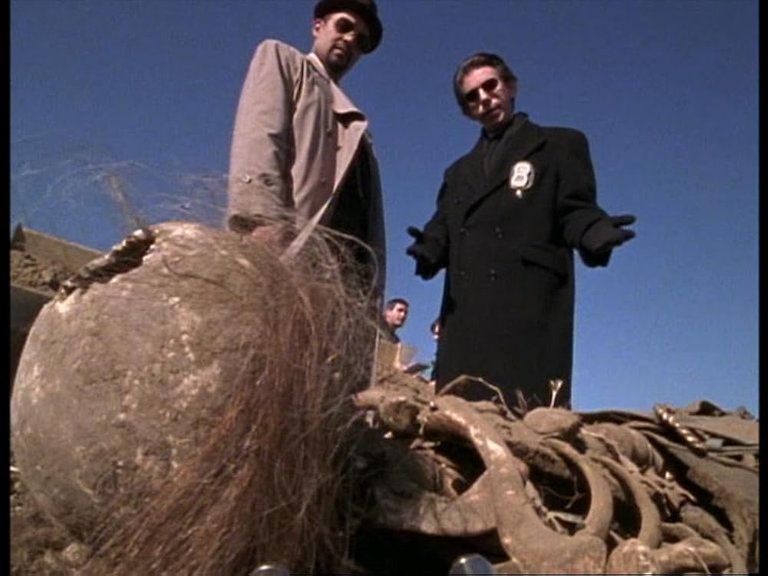Television Review: Bones of Contention (Homicide: Life on the Street, S7X11, 1999)

Bones of Contention (S07E11)
Airdate: 15 January 1999
Written by: Jason Yoshimura
Directed by: Brad Anderson
Running Time: 43 minutes
By the time Homicide: Life on the Street reached the midpoint of its seventh and final season, its creative staff had long since lost the spark that once defined the show’s gritty, realistic portrayal of police work. Episodes that might have felt fresh and inventive in earlier years now felt repetitive, their plots strained and their characters underutilised. Bones of Contention, an episode centred around the discovery of a decades-old skeleton, epitomises this decline. What could have been a compelling exploration of cold-case dynamics instead settles into the show’s familiar rhythms, offering little more than a tired retread of its own formulas.
The episode opens on a construction site in Baltimore, where workers unearth human remains. Detectives Munch and Lewis are assigned to investigate, though their lack of enthusiasm is palpable. The skeleton is identified as Carrie-Mae Reeves, a troubled young woman who vanished in 1987. Through interviews with her mother and teenage daughter, the detectives uncover links to an unsolved bank robbery orchestrated by a trio of criminals: Raphael Sykes (Rocco Sisto), now serving a life sentence, and Angelo Mancini (Skip Sudduth), a parolee claiming to have reformed. The third member, already deceased, leaves the duo with enough evidence to implicate Mancini in the robbery and Sykes in Carrie-Mae’s murder. Yet the resolution feels underwhelming, as Munch and Lewis speculate that Carrie-Mae might have stolen loot—despite her apparent violent demise. The plot, while serviceable, lacks the complexity or emotional weight that once distinguished Homicide’s cold-case narratives.
The episode’s primary strength lies in its lead performances, particularly Richard Belzer’s Munch, whose dry wit and ironic asides briefly elevate the material. A meta-moment occurs when Munch complains about being saddled with cases where the victims been dead for years, a line that inadvertently underscores the show’s creative exhaustion. The mystery itself is solved with uncharacteristic speed, its resolution more reliant on procedural convenience than genuine suspense. What should have been a meditation on the persistence of violence or the failures of justice instead feels like a placeholder, a reminder that Homicide’s golden era had long since passed.
Beyond its main storyline, Bones of Contention descends into a series of uninspired subplots. Perhaps most cringe-inducing is the subplot involving Detectives Falsone and Ballard, whose romance has long been a point of awkward tension. Lt. Giardello, in a move that feels more sitcom than drama, threatens to transfer one of them unless they end their relationship. The pair reluctantly agree but continue their affair in secret, a contrived conflict that undermines the show’s typically nuanced handling of workplace dynamics. This subplot, meant to address the oddity of the characters’ relationship, instead highlights the writers’ inability to navigate it with subtlety, reducing it to a juvenile game.
Meanwhile, Detective Shepard, still recovering from a brutal beating, engages in a conversation with fellow female officer Stivers about the unique vulnerabilities faced by women in law enforcement. The topic is intriguing—particularly in a show known for its unflinching realism—but the dialogue feels rushed and underdeveloped. The scene, which could have explored the challenges of female camaraderie in a male-dominated field, instead serves as little more than filler, its potential left unmined.
The episode does offer a few moments of historical resonance, particularly through Munch’s left-leaning rants. During a conversation with Lewis, he references the 1980s savings and loans scandals, sarcastically critiquing Reagan-era policies—a tangent that both distracts from the plot and underscores Munch’s role as a political foil to Lewis’s more moderate worldview. Lewis, meanwhile, defends Reagan’s legacy, noting his Alzheimer’s-induced decline, a juxtaposition that feels more like a cheap ideological punchline than a meaningful exploration of politics. A later scene with Higby, a detective from the Missing Persons Squad, touches on the bureaucratic headaches of transitioning from paper to computer records, a detail that might interest fans of procedural authenticity but feels like a distraction from the episode’s already thin narrative.
Ultimately, Bones of Contention is a hollow entry in a series that once thrived on its ability to balance procedural storytelling with humanistic depth. Its cold-case framework, once a vehicle for examining societal rot or individual trauma, here feels formulaic, its resolution too pat to carry emotional weight. The subplots, rather than enriching the story, reveal a creative team struggling to find relevance in its final season. For history buffs or die-hard fans, the nods to Reagan-era politics or the show’s own procedural quirks might provide minor satisfaction. For everyone else, Bones of Contention stands as a melancholy reminder of how far Homicide had fallen from its peak—a show once celebrated for its grit and innovation, now reduced to rehashing its own clichés.
RATING: 5/10 (++)
Blog in Croatian https://draxblog.com
Blog in English https://draxreview.wordpress.com/
InLeo blog https://inleo.io/@drax.leo
LeoDex: https://leodex.io/?ref=drax
Hiveonboard: https://hiveonboard.com?ref=drax
Rising Star game: https://www.risingstargame.com?referrer=drax
1Inch: https://1inch.exchange/#/r/0x83823d8CCB74F828148258BB4457642124b1328e
BTC donations: 1EWxiMiP6iiG9rger3NuUSd6HByaxQWafG
ETH donations: 0xB305F144323b99e6f8b1d66f5D7DE78B498C32A7
BCH donations: qpvxw0jax79lhmvlgcldkzpqanf03r9cjv8y6gtmk9